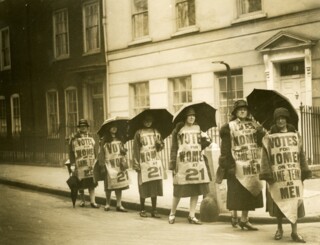At the Women’s Library
Joanna Biggs
At the end of last month, it was decided that the archive of the Women’s Library was to move from a university in the East End to a university in central London. ‘LSE saves Women’s Library from closure,’ the Guardian announced. London Met needs to save money; LSE has room in the new library it’s building – nothing could be more practical. All that will be lost is a purpose-built, award-winning, lottery-funded building that has been standing for only ten years (and which may turn out to be worth more demolished). Woolf wasn’t joking when she said a room of one’s own needed ‘a lock on the door’.
The archive, established in 1867 from the papers of Millicent Fawcett’s National Union of Women’s Suffrage Societies, got its first home in 1926, a converted pub in Westminster, then moved around London until the papers were taken on by London Met in 1977. There they were held in a basement that periodically flooded with rainwater and sewage, and so London Met found a new site in 1998: the old Goulston Square model wash houses behind one of their existing buildings on Whitechapel High Street. The Women’s Library opened in 2002, 135 years after it was established.
The Guardian and English PEN have painted LSE as rescuers: they will be building a dedicated space for the collection, which won’t be broken up; they will take on the staff; they too have a link to the women’s movement (the headquarters of the Pankhursts’ Women’s Social and Political Union once stood where the LSE campus now is). And perhaps an offer like LSE’s is all that could be hoped for in the current climate. All Souls College, Oxford is selling the building that houses Kensal Rise library, defended by Zadie Smith and Alan Bennett, after the council withdrew its support; a plot and a building in a niceish bit of London is worth an alarming amount of money to universities that see themselves as businesses. Kensal Rise library will be mostly flats with a bit of library. You would think that a place like Oxford or LSE would stand up for the notion that people should have books and somewhere to read. Or would at least know how ridiculous they look: the mathematicians taking board books away from two-year-olds and the political scientists hoarding copies of Fat is a Feminist Issue.
It shouldn’t be too much to ask to keep the building, built on land donated by Tower Hamlets council with £4.2 million of lottery money, in one of the country’s most deprived boroughs. As its architect, Clare Wright, has pointed out, the building couldn’t easily be used for anything else: the majority of the rooms are designed to keep out light and preserve the collections. (Surely even property developers couldn’t market windowless flats, even on the edge of Spitalfields.) But women’s buildings have a tendency to disappear: they are made into union headquarters, or hotels, or shops, or knocked down to make way for universities. The Save the Women’s Library Campaign is simply asking for LSE to meet and work with them to find a way for the papers to stay in the place that was built for them.
In the meantime, The Long March to Equality: Treasures of the Women’s Library, an exhibition which opened on 17 October, has a valedictory feel to it. There’s a rare first edition of Wollstonecraft’s A Vindication of the Rights of Woman (beside a John Opie engraving of her, with very hot cheeks); there are Unesco-protected documents, including the minutes of the first NUWSS meeting on 22 January 1896 with ‘Miss Fawcett in the chair’; there’s a pressed white Madonna lily carried at Emily Wilding Davison’s funeral and her tiny brown leather purse with the return portion of her ticket to Epsom. There’s the menu for the Victory Breakfast held at the Hotel Cecil in 1928 after the Equal Franchise Act gave women the same voting rights as men ten years after they were supposed to have them; there are a red tent and wire cutters from Greenham Common; there are Riot Grrl zines and a programme for the Ladyfest in London two years ago. The books are outnumbered by badges, posters, banners and flyers, the remainders of campaigns fought, won and forgotten. I walked round astonished: did they have to fight to stop the Elizabeth Garrett Anderson Hospital from being knocked down in the 1970s too?
Just as the librarian announced that the library was about to close for the evening, my eye was caught by a WSPU banner in the suffragette colours of green, white and purple. No slogan, just a stylised rose and two names: CHARLOTTE BRONTE EMILY BRONTE. I wondered if they’d lend it. If suffragettes thought those names enough to get us the vote, they must be enough to let us keep our library.

Comments
btw, does Joanna Biggs think the EGA hospital has NOT been knocked down?
Personally as one of core group at London Guildhall University that developed the bid to HLF for the building I feel a massive sense of failure, but LSE's offer has at least secured a measure of security for the collections and some exciting potential for positive developments. It is a very different future than the one I envisaged back in 1980s when we started to work on the HLF bid - but as Joanna Bigg's review of the current exhibition-The Long March to Equality: Treasures of the Women's Library shows we did at least achieve one of our main aims- to bring library, museum and archive collections and approaches together to illuminate appreciation and understanding. LSE has a lot to live up to but at this stage I prefer to be a long term optimist then a short term pessimist....